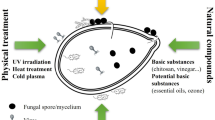Abstract
Rice blast caused by Pyricularia oryzae is considered as a major disease because of its wide geographic distribution and destructiveness under favourable conditions causing serious yield losses. The present study was undertaken to manage this disease under field conditions. Therefore, in vitro evaluation of biocontrol agents and fungicides against P. oryzae was done under laboratory conditions and a field experiment was conducted to evaluate the efficacy of bio-control agents viz., T. harzianum and T. viride and fungicides viz., tricyclazole and tebuconazole 50% + trifloxystrobin 25%, alone as well as in combinations against rice blast. In vitro studies revealed that among the biocontrol agents, maximum growth inhibition (43.99%) was recorded in T. harzianum. Among the fungicides, tricyclazole was the most effective in inhibiting the growth of P. oryzae at all concentrations. Under field conditions, combination of seed treatment with tricyclazole @ 2 g/kg of seed + two foliar sprays of tebuconazole 50% + trifloxystrobin 25% @ 0.1 per cent was the best in controlling the disease with the highest disease control (83.09 and 77.37%) and gave the highest grain yield 29.70 and 29.45 q/ha during Kharif 2018 and 2019, respectively.

Similar content being viewed by others
Data availability
All data generated or analyzed during this study is included in the manuscript.
References
Ali S, Moktan MW, Ghimiray TS, Khalko S (2014) Occurrence and chemical management of blast disease of rice in hill agro-climatic zone of West Bengal Int. J Plant Prot 11:116–118
Anonymous (1996) Standard evaluation system for rice. International Rice Research Institute, Manila, Phillipines, p 52
Couch BC, Kohn LM (2002) A multilocus gene genealogy concordant with host preference indicates segregation of a new species Magnaporthe oryzae. Mycologia 94:683–693
Dean R, Van Kan JAL, Pretorius ZA, Hammond-Kosack KE, Di Pietro A, Spanu PD, Rudd JJ (2012) The top 10 fungal pathogens in molecular plant pathology. Mol Plant Path 13:414–430
Dennis C, Webster J (1971) Antagonistic properties of species groups of Trichoderma-III. Production of volatile antibiotics. Trans Brit Mycol Soc 57:363–369
Gomez KA, Gomez AA (1984) Statistical procedures for agricultural research. Wiley, New York
Koutroubas SD, Katsantonis D, Ntanos DA, Lupotto E (2009) Blast disease influence on agronomic and quality traits of rice varieties under Mediterranean conditions. Turk J Agric 33:487–494
Kulmitra AK, Sahu N, Kumar VBS, Thejesha AG, Ghosh A, Gulnaz Y (2017) In vitro evaluation of bioagents against Pyricularia oryzae (cav.) causing rice blast disease. Agric Sci Dig 37:247–248
Kumar B (2011) Management of blast disease of finger millet (Eleusine coracana) in mid-western Himalayas. Indian Phytopathol 64:154–158
Kumar B (2012) Management of important diseases of barnyard millet (Echinochloa frumentacea) in mid- western Himalayas. Indian Phytopathol 65:300–302
Nagaraja A, Kumar B, Raguchander T, Hota AK, Patro TSSK, Devaraje Gowda P, Ekka Savita, Gowda MVC (2012) Impact of disease management practices on finger millet blast and grain yield. Indian Phytopathol 65:356–359
Naik BVK, Jamadar MM (2014) In-vitro bioassay of different fungicides against blast of pearl millet caused by Pyricularia grisea (Cooke.) Sacc. Kar J Agril Sci 27:88–90
Nene YL, Thapliyal BW (1979) Fungicides in plant disease control. Oxford and IBH Publisher House, New Delhi
Ramteke NB, Mondhe MK, Gibhakate P, Jadhav BR (2011) Biological management of leaf blast [Pyricularia grisea (Cooke) Sacc.] of pearl millet. J Plant Dis Sci 6:202–203
Rao CV, Kumar PA (2018) Integrated disease management of rice blast caused by Pyricularia oryzae (Sacc). Int J Curr Microbiol Appl Sci 7:2952–2958
Senthil R, Shanmugapackiam S, Raguchander T (2012) Evaluation of biocontrol agents and fungicides for the management of blast disease of finger millet. J Mycol Plant Pathol 42:454–458
Srinivasulu B, Kumar KKV, Aruna K, Prasad KJ, Rao DVR (2005) In vitro antagonism of three Trichoderma spp. against Sclerotium rolfsii Sacc., a collar rot pathogen in elephant foot yam. J Biol Control 19:167–171
Subhalakshmi T, Devi SI (2017) Blast of rice in Manipur and its biocontrol by Pseudomonas fluorescens and Trichoderma spp. Int J Curr Microbiol Appl Sci 6:1619–1634
TeBeest DO, Guerber C, Ditmore M (2007) Rice blast. Plant Health Instructor. https://doi.org/10.1094/PHI-I-2007-0313-07
Vincent JM (1947) Distortion of fungal hyphae in the presence of certain inhibitors. Nature 159:850
Author information
Authors and Affiliations
Corresponding author
Ethics declarations
Ethical approval
The article does not contain any human studies with human participants or animals performed by any authors.
Informed consent
Informed consent was obtained from all individual participants included in this study.
Conflict of interest
The authors declare no conflict of interest.
Additional information
Publisher’s Note
Springer Nature remains neutral with regard to jurisdictional claims in published maps and institutional affiliations.
Rights and permissions
Springer Nature or its licensor (e.g. a society or other partner) holds exclusive rights to this article under a publishing agreement with the author(s) or other rightsholder(s); author self-archiving of the accepted manuscript version of this article is solely governed by the terms of such publishing agreement and applicable law.
About this article
Cite this article
Pandit, D., Singh, A.K., Razdan, V.K. et al. Management of rice blast disease caused by Pyricularia oryzae through application of biocontrol agents and fungicides alone and in possible combinations. Indian Phytopathology (2024). https://doi.org/10.1007/s42360-024-00733-1
Received:
Revised:
Accepted:
Published:
DOI: https://doi.org/10.1007/s42360-024-00733-1




